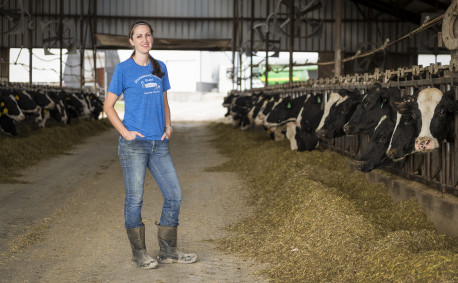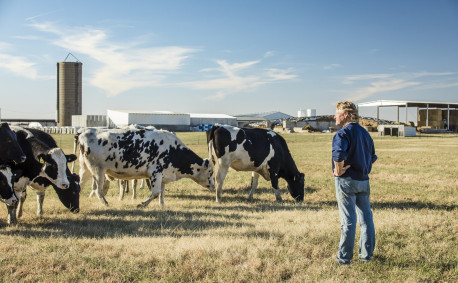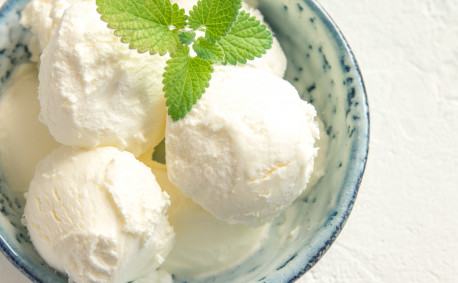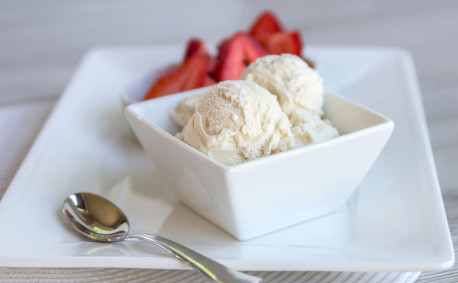Fun Facts About Ice Cream
There’s nothing like a cold and creamy treat to beat the heat, but we could indulge in ice cream any time of year. We have dairy farmers to thank for this favorite dessert — you can’t have ice cream without dairy! For a dessert to officially be considered ice cream, it must contain at least 10 percent milkfat.
Whether you prefer yours in a cone, on a pie, in a cookie sandwich or cooked (we’re looking at you, fried ice cream and baked Alaska!), there’s a method and flavor to make nearly everyone’s taste buds do a happy dance.
Ice Cream Fun Facts
Get the scoop on this freezer staple and some of its delicious cousins with these fun ice cream facts. You never know, they just might come in handy during your next trivia night.
- The top three ice cream flavors are chocolate, cookies and cream, and vanilla.
- The average American consumes 23 pounds of ice cream each year. (We’re pretty sure we’re on the high side of that average!)
- About 9 percent of dairy milk produced in the U.S. goes toward making ice cream.
- America produces more than a billion gallons of ice cream each year. (The total for 2022 was 1.38 billion gallons.)
- Most manufacturers of ice cream and other frozen desserts are family-owned and have been in business for more than 50 years.
- Brain freeze happens when you eat ice cream or other cold foods so quickly that the blood vessels in your head expand suddenly to increase blood flow and help warm up your mouth. The result is a temporary headache.
- The world's largest ice cream scoop, as determined by Guinness World Records, appeared at a strawberry festival in Cedarburg, Wisconsin, in 2014. The giant scoop weighed 3,010 pounds and measured about 5 feet, 6 inches tall by 6 feet, 2 inches wide. (The largest cone measuring over 10 feet tall was made in Norway in 2015. The largest sundae weighing 54,917 pounds was made in Canada in 1988.)
- As a seasonal treat, ice cream’s production ramps up in March and winds down in August, with June being the biggest month for production.
- July is National Ice Cream Month in the U.S. We can get behind that!
What’s in Ice Cream?
Ice cream has several key ingredients.
- Dairy is the main ingredient for traditional ice cream, but the type varies. Contrary to what you might expect, cream is not necessarily incorporated. Some recipes use cream, others milk, and some a combination of the two.
- They don’t call it a sweet treat for nothing. Without sweeteners, ice cream wouldn’t be as delicious. Recipes call for sugar, honey or even corn syrup to make this dulcet delight.
- Whether you fall in the chocolate or vanilla camp (perhaps even fruit?), one thing we can all agree on is that ice cream wouldn’t be nearly as delicious without the flavorings. From extracts to cocoa powder to mix-ins, there are countless ways to make this dessert tantalizing to any taste bud.
- Some recipes also use stabilizers to give ice cream a smoother texture and emulsifiers to help it freeze more evenly.
Different Kinds of Cool and Creamy Treats
Sherbet, gelato and fro-yo—oh my! Ice cream has a lot of tasty kin. What makes them different? Here are some fun facts about other frozen treats:
- Soft serve and regular ice cream have the same ingredients. But soft serve machines add extra air while freezing the mixture without a hard freeze afterwards, which creates a soft consistency.
- Like ice cream, frozen custard must have at least 10 percent fat. However, frozen custard must also have 1.4 percent egg yolk solids, which is a dried ingredient, to officially be categorized as frozen custard.
- Gelato, which is Italy’s version of ice cream, doesn’t have as much fat as regular ice cream and is slow-churned.
How Ice Cream Is Made
Home chefs and industrial producers follow the same basic steps with a few variations.
- Prepare: Combine milk (or cream), sweeteners and eggs, if your recipe calls for them.
- Heat: This step is important for food safety, especially when using eggs. Heating to 161 degrees for at least 15 seconds is enough to pasteurize milk, killing bacteria.
- Smooth: Home chefs can strain their mixture to remove any lumps, making the final product as smooth as possible. Manufacturers have equipment to homogenize the mixture, which uses extreme pressures to disperse the fat evenly, creating a creamy texture.
- Cool: You don’t want to add flavors while the mixture is too hot, so it’s important to let the pasteurized mixture cool down.
- Flavor: This is when you can let your imagination run wild or stick with tradition. While home chefs might use small amounts of extracts or powders, manufacturers have giant tanks of their signature flavors.
- Churn: This step is all about freezing. The mixture goes into a special freezer with blades called dashers. The dashers mix the cooled ingredients within the freezing chamber. As they do so, they scrape ice crystals from the edge of the container back into the mix, while introducing air, which softens the mixture and brings it to an even frozen consistency. The addition of air also increases the volume of ice cream. After this step, ice cream can grow 60 to 100 percent larger by volume.
- Freeze and enjoy: This is the step we’re all waiting for. Whether done with a countertop ice cream maker or at an industrial plant, the end result is a cold, creamy treat.
History of Ice Cream
No one knows the exact origin of ice cream, but it’s been around in some form or other for centuries. Here are some facts sprinkled with legend.
- Ancient Romans were believed to eat ice flavored with fruit juice and wines, and Persians were known to enjoy a similar treat called sharbat around the same time. Arabs, who had plentiful dairy herds, adjusted the Persian recipe, adding milk and sugar.
- Marco Polo is believed to have brought a sherbet-like recipe back to Italy from his travels in the Far East in the 1200s.
- Catherine de Medici, an Italian noblewoman, introduced ice cream to France when she married Henry II in 1553.
- Charles I served “cream ice” in England in the 1600s.
- An Italian chef sold an ancestor of today’s gelato in Paris in the late 1600s.
- Ice cream came on the scene in the U.S. in 1744 when the governor of Maryland served it to guests for dessert.
- The first commercial ice cream plant was established in Baltimore in 1851.
Famous Ice Cream Lovers
Some notable leaders have enjoyed this cool and creamy treat (or a variation) throughout the years.
- Alexander the Great was a fan of snow cones. Well, kind of. He ate a mixture of snow and ice sweetened with honey and nectar.
- President George Washington spent $200 on ice cream in the summer of 1790 according to records kept by a vendor in New York. That translates to about $5,000 in today’s dollars!
- Ronald Reagan may have been known for his love of jelly beans, but he was a fan of ice cream too. President Reagan declared July to be National Ice Cream Month in 1984. (The third Sunday of the month is also dedicated to National Ice Cream Day.)
Ice Cream in Kansas
Although Kansas doesn’t have a particular claim to fame when it comes to ice cream, some companies shaped the history for Kansans to enjoy this sweet treat.
- Scott Brothers Ice Cream Company, founded in Topeka in 1879, was believed to be the first ice cream manufacturing company in Kansas. The company sold ice cream and other dairy products for a century before closing in 1979.
- Steffen’s Bakery and Restaurant, founded in Wichita in 1882, served ice cream on special occasions before adding it to its regular rotation, growing to serve more than 20,000 gallons of ice cream per year. The company was the first to ship ice cream commercially in the U.S. and later became part of Hiland Dairy Foods Company (which no longer produces ice cream).
- Meadowbrook Creamery, founded in Emporia in 1933, started off processing butter before shifting its focus to other dairy products. The company was a forerunner to Peter Pan Ice Cream Company. When Bill Braum sold Peter Pan in 1967, Steffen’s took over the operation and Braum wasn’t allowed to sell ice cream in Kansas for 10 years. Today, Braum’s Ice Cream operates across the Midwest.
Plus, Kansas dairy farmers help produce milk so people across the country can enjoy this tasty treat.
- Kansas is home to about 175,000 milk cows on more than 200 dairy farms.
- The average Kansas dairy cow produces about 7.55 gallons of milk per day. That’s more than 2,755 gallons of milk over the course of a typical year.
- Kansas ranks 16th in the nation for milk production, with our dairies producing 4.14 billion pounds of milk in 2022.
Meet Some Kansas Dairy Farmers
If this has you craving a scoop, check out some local ice cream shops, courtesy of Kansas Tourism.







